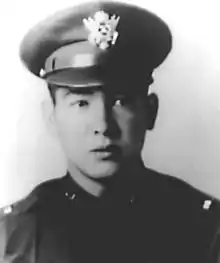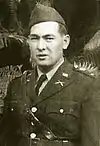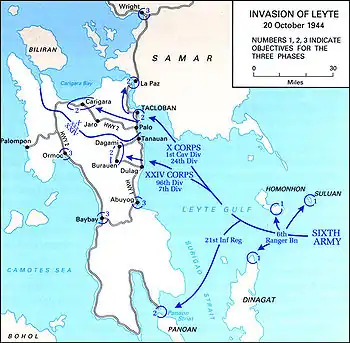Francis B. Wai
Francis Brown Wai (April 14, 1917 – October 20, 1944) was a captain in the United States Army and received the Medal of Honor for actions during the recapture of the Philippines from Japan in 1944. As a youngster, Wai liked to surf and he played several sports in high school and college. He graduated from college with a degree in finance. Although he initially planned to work with his father, he joined the Hawaii National Guard, commissioned a lieutenant. Wai was sent with his unit to fight in World War II and he was killed during the U.S. amphibious assault on Leyte, Philippines.
Francis Brown Wai | |
|---|---|
 Captain Francis B. Wai | |
| Born | April 14, 1917 Honolulu, Territory of Hawaii |
| Died | October 20, 1944 (aged 27) Leyte, Philippines † |
| Place of burial | |
| Allegiance | |
| Service/ | |
| Years of service | 1940 – 1944 |
| Rank | |
| Unit | 34th Infantry Regiment, 24th Infantry Division |
| Battles/wars | World War II |
| Awards | Medal of Honor Distinguished Service Cross[n 1] Purple Heart |
He was initially awarded the Distinguished Service Cross, the United States' second highest decoration for valor. After an extensive review of awards in 2000, his medal was upgraded to the Medal of Honor.[1][2] To date, Wai is the only Chinese American and one of only two non-Japanese Asian American officers to receive the medal.[3]
Early life
Wai was the child of a Native Hawaiian mother and a Chinese father. Growing up, he often surfed with Duke Kahanamoku, regarded as the father of surfing, and Buster Crabbe, who later became an actor. He attended the Punahou School in Honolulu where he earned athletic letters in track, football and baseball. He went to college at the Sacramento Junior College before transferring to UCLA.[4] At UCLA, he was a four sport athlete and graduated in 1939 with a bachelor's degree in Banking and Finance.[5] He intended to work alongside his father in real estate and banking but instead joined the military upon the outbreak of World War II.[5]
Military service and death

After his graduation, Wai enlisted in the Hawaii National Guard and was called into active duty before the United States' entrance into World War II. He received a commission as an officer and completed Officer Candidate School in 1941.[6] His commission was rare at a time when few Asian Americans were allowed to serve in combat leadership roles.[5][6] He was eventually assigned to the 34th Infantry Regiment of the 24th Infantry Division with the rank of Captain.[5] The 24th Division, based at Schofield Barracks, Oahu, was among the first American units to be involved in the Pacific Theater, exchanging fire with Japanese aircraft during the December 7, 1941 attack on Pearl Harbor.[5]
Operation Reckless
In May 1943, Captain Wai deployed to Australia with the 24th Infantry Division and by September 19, 1943, the unit was at Camp Caves, near Rockhampton, on the eastern coast of Australia. Wai and the rest of the unit began intensive combat training.[7] With training completed, the division moved to Goodenough Island on January 31, 1944, to prepare for Operation Reckless, the amphibious invasion of Hollandia, Netherlands New Guinea (now Jayapura, in the Papua province of Indonesia).[8]
The 24th landed at Tanahmerah Bay on April 22, 1944 and seized the Hollandia Airdrome despite torrential rain and marshy terrain.[7] Shortly after the Hollandia landing, the division's 34th Infantry Regiment moved to Biak to reinforce the 41st Infantry Division. Wai's regiment captured the Sorido and Borokoe airdromes before returning to the division on Hollandia in July.[7] In two months, Wai and his unit had crossed New Guinea and recaptured three airdromes from the Japanese.[9]
Leyte

After occupying the Hollandia area, Wai was assigned to X Corps of the Sixth United States Army in preparation for the invasion of the Philippines. On October 20, 1944, his division was paired with the 1st Cavalry Division within X Corps, and the two divisions made an assault landing at Leyte.[10] When Captain Wai landed at Red Beach, the Japanese forces stationed on the island concentrated their fire on the waves of incoming troops from gun positions located in a palm grove bounded by submerged rice paddies. When Wai arrived on the beach in the fifth wave, he found the soldiers there to be leaderless, disorganized, and pinned down on the open beach. Assuming command, he moved through the rice paddies, without cover. His demeanor and example inspired the other men to follow him. With deliberate disregard of his own personal safety, he advanced without cover to draw Japanese machine gun and rifle fire, thus exposing the locations of the entrenched Japanese forces. Systematically, the Japanese positions were assaulted and overcome. Wai was killed leading an assault against the last Japanese pillbox in the area.[11] For his actions during the landing on Leyte, Wai was posthumously awarded the Distinguished Service Cross. After the war, his remains were interred at the National Memorial Cemetery of the Pacific in Hawaii.[12]
Military awards and honors
In 1996, amid allegations of prejudicial treatment of Asian Americans in uniform in World War II, Congress directed Louis Caldera, then Secretary of the Army, to conduct a full review of military records.[1][2] The review concluded that 22 Asian Americans, including Wai, did not receive full consideration for the Medal of Honor and in 2000, Wai's Distinguished Service Cross was upgraded to the Medal of Honor.[13]
Of those whose medals were upgraded, Wai was one of only two who did not belong to the predominantly Japanese American 442nd Regimental Combat Team/100th Infantry Battalion; the other being Rudolph B. Davila of the 7th Infantry.[14] At a White House ceremony June 20, 2000, President Bill Clinton presented the Medal of Honor to 22 Asian Americans whose Distinguished Service Crosses were upgraded to the Medal of Honor.[11]
During the course of his short military career, Wai earned eight awards and decorations.
 | |||||||||||
Medal of Honor citation
Rank and organization: Captain, U.S. Army, Headquarters, 34th Infantry
Place and date: Leyte, Philippine Islands, October 20, 1944
Entered service at: Honolulu, Hawaii
Born: Honolulu, Hawaii
Citation:
Captain Francis B. Wai distinguished himself by extraordinary heroism in action, on 20 October 1944, in Leyte, Philippine Islands. Captain Wai landed at Red Beach, Leyte, in the face of accurate, concentrated enemy fire from gun positions advantageously located in a palm grove bounded by submerged rice paddies. Finding the first four waves of American soldiers leaderless, disorganized, and pinned down on the open beach, he immediately assumed command. Issuing clear and concise orders, and disregarding heavy enemy machine gun and rifle fire, he began to move inland through the rice paddies without cover. The men, inspired by his cool demeanor and heroic example, rose from their positions and followed him. During the advance, Captain Wai repeatedly determined the locations of enemy strong points by deliberately exposing himself to draw their fire. In leading an assault upon the last remaining Japanese pillbox in the area, he was killed by its occupants. Captain Wai's courageous, aggressive leadership inspired the men, even after his death, to advance and destroy the enemy. His intrepid and determined efforts were largely responsible for the rapidity with which the initial beachhead was secured. Captain Wai's extraordinary heroism and devotion to duty are in keeping with the highest traditions of military service and reflect great credit on him, his unit, and the United States Army.[11][15]
Wai was inducted into the UCLA Athletics Hall of Fame on October 11, 2014.
See also
Footnotes
- Wai was originally given the Distinguished Service Cross for his actions during World War II. Although this Medal was upgraded to the Medal of Honor in the 1990s it was the medal he had for nearly 50 years.
References
- Inline
- Williams, Rudi (May 19, 2000). "21 Asian American World War II Vets to Get Medal of Honor". American Forces Press Service. Retrieved February 21, 2008.
- McDermott, Anne (June 21, 2000). "Clinton awards Medal of Honor to 22 Asian-American World War II veterans". CNN. Retrieved February 21, 2008.
- Owens 2004, p. 22.
- Lee, Meredith (11 November 2013). "Captain Francis B. Wai: UCLA and American Hero". uclabruins.com. UCLA Athletics. Archived from the original on 2 February 2014. Retrieved 26 August 2014.
- "Francis Wai: A Hero Remembered". Ethen Lieser. Archived from the original on December 2, 2008. Retrieved January 11, 2010.
- Sterner 2007, p. 135.
- Almanac, p. 527.
- Marston 2005, p. 134.
- Marston 2005, p. 190.
- Horner 2003, p. 56.
- "Asian-Pacific American World War II Medal of Honor recipients". United States Army Center of Military History. August 3, 2009. Retrieved August 25, 2009.
- "Cemeteries – National Memorial Cemetery of the Pacific". U.S. Dept. of Veteran Affairs. Retrieved February 21, 2008.
- Stenger, Dieter (December 2014). "Redemption at Leyte: U.S. Army Captain Francis B. Wai". United States Army Center of Military History. Retrieved July 4, 2016.
- Williams, Rudi (June 28, 2000). "22 Asian Americans Inducted into Hall of Heroes". American Forces Press Service. Retrieved February 21, 2008.
- "Home of Heroes". C. Douglass Sterner. Retrieved February 21, 2008.
- General
- Owens, Ron (2004). Medal of Honor: Historical Facts & Figures. New York: Turner Publishing Company. ISBN 1-56311-995-1
- Sterner, C. Douglass (2007). Go for Broke: The Nisei Warriors of World War II Who Conquered Germany. New York: American Legacy Media. ISBN 0-9796896-1-9
- Marston, Daniel (2005). The Pacific War Companion: from Pearl Harbor to Hiroshima. Osprey Publishing. ISBN 9781846032127.
- Army Almanac: A Book of Facts Concerning the Army of the United States. United States Government Printing Office. 1959.
- Horner, David (2003). The Second World War, Vol. 1: The Pacific. Osprey Publishing. ISBN 978-0-415-96845-4.
External links
- "Francis B. Wai". Hall of Valor. Military Times. Retrieved January 11, 2010.